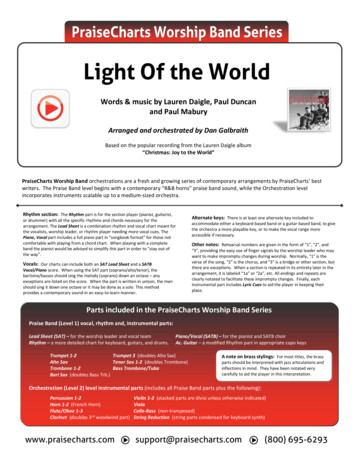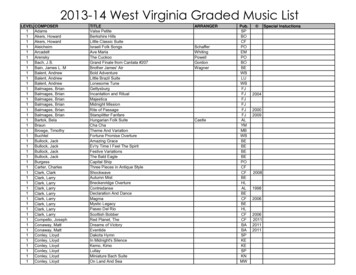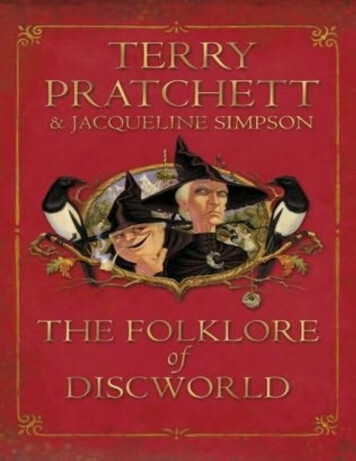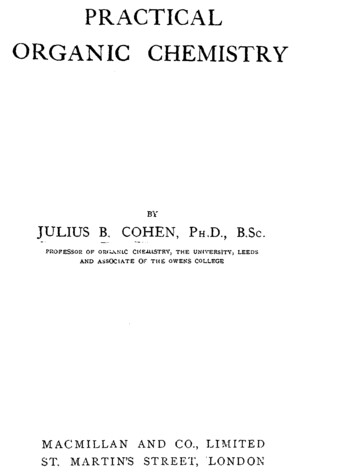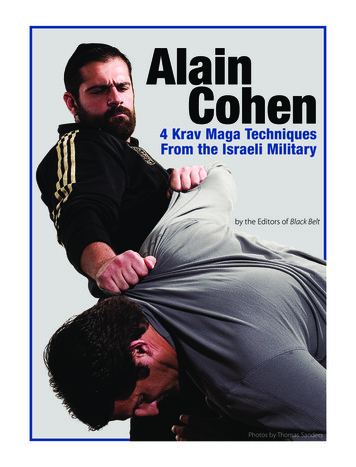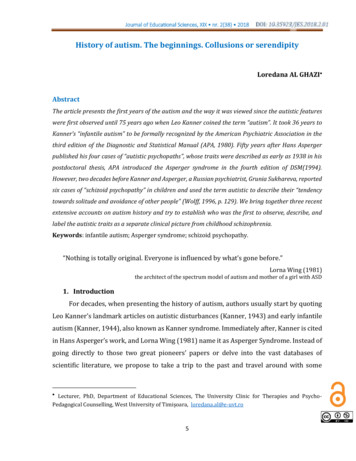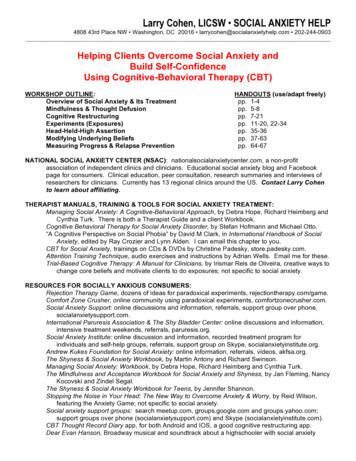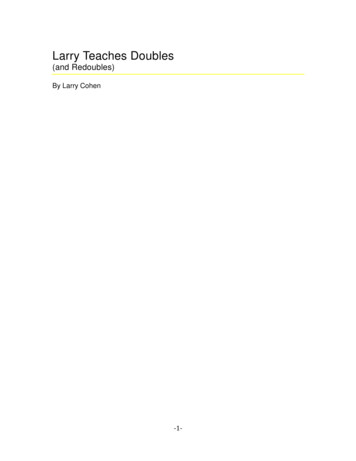
Transcription
Larry Teaches Doubles(and Redoubles)By Larry Cohen-1-
Larry Teaches Doubles (and Redoubles)Copyright 2013 by Larry CohenAll Rights reserved. No part of this publication may be reproduced,stored in a retrieval system, or transmitted in any form, or by anymeans, electronic, photocopying, recording, or otherwise, withoutwritten permission from the author.Printed in U.S.A.First Edition-2-
TABLE OF CONTENTSINTRODUCTION. 5THE TAKEOUT DOUBLE . 7Doubling and Bidding Again . 8Versus Preempts . 8Doubles After Two Opposing Bids . 8Quiz . 9Quiz . 10Quiz . 10Quiz . 10Responses To Partner’s Takeout Double.11Quiz . 12Quiz . 12Takeout Doubler’s Later Actions .13Quiz . 14Balancing Seat Doubles .15Quiz . 15Quiz . 15Quiz . 16Equal-Level Conversion. 16Converting A Takeout Double For Penalty . 17Quiz . 17Four-Level Doubles . 18Quiz . 19Quiz . 19Quiz . 20NEGATIVE DOUBLES . 21Quiz . 22Quiz . 22On What Level? .23Quiz . 23Quiz . 25RESPONSIVE DOUBLES . 28Quiz: . 30Quiz . 30What If Their Responder Changes Suit? . 31-3-
Quiz . 33Snapdragon . 34SUPPORT DOUBLES . 35When Are Support Doubles On? . 37Quiz . 37Quiz . 38LOW LEVEL DOUBLES. 41Dsi Doubles . 41Takeout Doubles By Opener . 46LEAD DIRECTING, MAXIMAL, and OTHER DOUBLES . 48LEAD-DIRECTING DOUBLES . 48Quiz . 49LIGHTNER DOUBLES. 50Quiz . 51OTHER DOUBLES . 52REDOUBLES. 53SOS/Scrambling Redoubles . 53Support Redoubles . 55Control-Showing Redoubles . 55Rosenkranz Redoubles . 56Strength–Showing Redoubles. 56Business Redoubles . 58Miscellaneous Redoubles. 60Scoring. 61Alertability. 62Wrap-Up . 63-4-
INTRODUCTIONAlong with my good friend Bernie Chazen, I used to give entire multi-dayseminars on doubles. We always started the same way. Bernie would waddle upto the microphone (picture 300 pounds of man, wearing suspenders) and in hisbooming voice would announce, “The penalty double has died and gone toheaven.” Sadly, he is now in heaven with those penalty doubles.In modern bridge, very few doubles actually mean, “I double the stakes—let’splay for penalties.” In this book, my goal is to simplify all of the mainstreamdoubles in the game. I’ve included many quizzes so that the reader can test hisknowledge as he works his way through the book.We’ll start with the two most basic non-penalty doubles: Takeout Doubles andNegative Doubles. Later, we’ll explore the many other doubles (and redoubles)which have permeated modern competitive bidding.-5-
-6-
THE TAKEOUT DOUBLEThis is the oldest non-penalty double in thegame, and has been around since theOPPONENTYOUorigins of contract bridge. When RHO(Right-Hand-Opponent) opens the bidding,Opening Suit BidDoubleit makes no sense to use double forpenalty; low level contracts are very difficult to defeat, and defenders are harshlypunished in the scoring for allowing a doubled contract to make. Therefore, thisdouble has always been played as “takeout.”The normal range is “about an opening bid” (count for shape, especiallyshortness in the opponent’s suit) up to approximately 17-18 HCP. If the takeoutdoubler has more than 17-18, he doubles and then plans to bid again.A common error committed by inexperienced players is to make a TakeoutDouble of 1 with this type of hand: A2 KJ82 KJ2 J987.Their partner answers 1 (you know how partners are), and they think it is okayto now correct to 1NT. Not okay! Doubling and then bidding again shows 18 . Ifyou double and then bid 1NT it shows more than a 15-17 1NT overcall, so about18 to 20 (balanced). Passing partner in 1 (usually a 4-2 fit) is another disastrousoption.For this reason, a Takeout-Doubler (in the normal 12/13 to 17/18 range) must beable to tolerate all three unbid suits. “Tolerate,” means at least a tripleton. Bottomline: Do not make a Takeout Double without holding either 18 HCP or at leastthree cards in every suit outside the suit being doubled. Don’t get too concernedwith counting exactly 17 or 18. I would consider this 17-count too good for a 1 overcall of 1 : KQJ1098 AQJ 2 A32.I would start with a double. Notice that support for all three suits is not neededwhen you have the “big hand” and intend to bid again anyway.I would simply overcall 1 with this 17-count (not quite good enough to doubleand then bid again): AQ765 KQ2 KQ J32.-7-
Doubling and Bidding AgainWhile doubling and bidding again shows more than 17/18 (any distribution), it isnot forcing. In other words, the partner of the Takeout Doubler doesn’t have tobid again.Here is a typical hand for doubling 1 and later bidding spades: AQJ98 32 AK2 AJ4.This hand is too strong to overcall 1 (which would show a maximum of 17points).OPENERYOURESPONDERPARTNER1 DoublePass1 Pass1 Pass(allowed to pass)With a really big hand (perhaps a game force), the Takeout Doubler must find astronger action than a non- forcing spade bid at his second turn.Versus PreemptsDoubling an opening preempt is still takeout, but requires a little more strength.Against a weak two-bid, a Takeout Double can be made with perfect 1-4-4-4 (onein their suit) shape and only 12 HCP. Without that perfect shape, however, thedoubler should have a little more strength. Against a three-level preempt, at leasta solid opening bid is required, and even more is needed against a four-levelpreempt (covered at the end of this chapter).Doubles After Two Opposing BidsTakeout Doubles can be made after both opponents have bid. Consider thishand: KQ98 A2 KJ53 632.After the opponents bid 1 —Pass—1 , a player holding length (4 or more cards)in both unbid suits (as above) can make a Takeout Double. After 1 —Pass—1NT, a double would indicate a Takeout Double of hearts. Also, a player with 18 can double after the opponents have bid two suits and then bid again.-8-
In modern bridge, very few doubles actually mean, “I double the stakes—let’s play for penalties.” In this book, my goal is to simplify all of the mainstream doubles in the game. I’ve included many quizzes so that the reader can test his knowled

